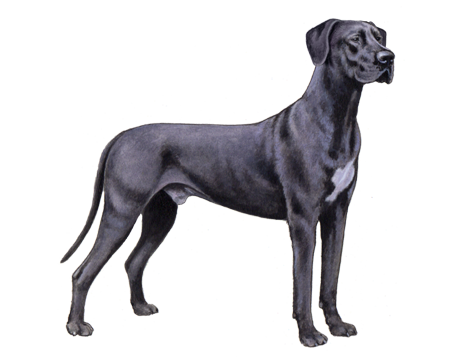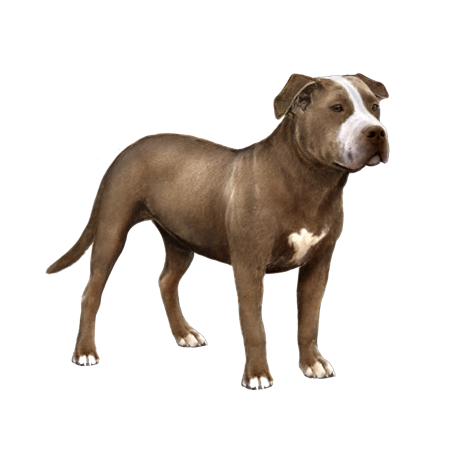
Great Dane
The Great Dane is a friendly, intelligent breed famous for its size. Despite their affectionate and often goofy demeanor, Great Danes make excellent guard dogs thanks to their loyalty and devotion to their people. There's plenty to love about these gentle giants.
Interested in discovering if your dog is a Great Dane?
Check out Wisdom Panel's DNA tests.

Great Dane Traits
General Appearance
Great Danes are impressive giants that loom over most other dogs. The breed has a sleek, athletic build and a muscular, yet elegant, body.
Coat and Colouring
There are six acceptable colors for the short coats of Great Danes: fawn, brindle, blue, black, harlequin, and mantle.
Distinctive Physical Traits
Great Danes are known for their considerable size. When standing on their hind legs, adult dogs are often taller than their owners!
Their heads are large, long, and narrow with deep and dark eyes, floppy ears, and a long and graceful neck. Their straight legs are set upright.
Great Dane Temperament
With a reputation for being good watchdogs and dependable home guardians, Great Danes usually have a pleasant, easy-going nature.
They aim to please, enjoy receiving attention, and have no trouble making friends wherever they go, thanks to their confidence. Great Danes are often known for their characteristic lean on people they like, and their ability to sit like humans on couches and large furniture.
Great Danes form strong bonds with their families and are patient, playful, and gentle with children. When properly socialized, Danes are outgoing toward strangers and generally good with other pets in the household.


Great Dane History
Evidence from Egyptian tombs suggests dogs resembling the Great Dane have existed for thousands of years. However, many believe that Great Danes come from an Asian Mastiff-type dog brought to Germany by ancient Iranian nomads. That's right: the Great Dane is not Danish at all, hailing instead from Germany.
Great Danes hunted boar in Germany during the 1500s. But it wasn't until the late 1800s that the breed became standardized in Germany and earned its own club in the United States.
Cropping of the Great Dane's ears is somewhat common in the United States. But it's rare in Europe. In fact, some countries such as Denmark, Australia, and New Zealand ban ear cropping altogether. The original purpose of ear cropping was to protect the dog's ears from wolves and boars during hunting. Today, the practice is widely considered cruel and unnecessary.
Great Dane Care
Nutrition
It's best to feed your Great Dane a high-quality dog food appropriate for their life stage (e.g., puppy, adult, senior). Great Danes may benefit from diets formulated specifically for large-breed dogs. In particular, large-breed puppy diets prevent young Danes from growing too fast, which may decrease the incidence or severity of hip dysplasia as they age.
Great Danes are prone to bloat (also known as twisted stomach). To help prevent bloat, break up their daily feedings into several meals, and use a food bowl designed to slow their rate of eating. When timing meals, avoid feeding them immediately before or after vigorous activity.
These are just a few ways you can help prevent this life-threatening condition. Your veterinarian is the best resource for other recommendations—including surgical options—for preventing bloat.
Grooming
Great Danes generally don't shed much due to their short, smooth coat.
But during shedding season (happens once or twice a year), they may leave behind quite a lot of hair. You can keep shedding to a minimum by brushing your pup weekly with a medium-bristle brush, rubber grooming mitt or tool, or hound glove.
Great Danes only need occasional baths unless they get into something that makes them particularly dirty—which isn't unheard of for these goofs! As with all breeds, regular nail trimming is a must. Overly long nails can cause the dog pain and problems walking or running.
Exercise
Despite its large size, the Great Dane needs daily exercise. Regular walks with their favorite person (or people) often do the trick. Danes make good jogging or hiking partners. But keep in mind that they should be at least two years old before engaging in these activities to prevent damage to their growing joints.
Great Danes also seem to enjoy dog sports—such as agility, tracking, weight pull, flyball, musical freestyle, and both rally and competitive obedience.
Training
Obedience training, including early socialization and puppy training classes, is a must for the large and powerful Great Dane.
This breed responds to firm and consistent training methods and learns quickly. But Danes can be stubborn, so keep plenty of treats and favorite toys on hand to use as rewards during training sessions.

Great Dane Genetic Health Conditions
-
Centronuclear Myopathy (Discovered in the Great Dane)
Centronuclear Myopathy (CNM) is a type of muscle disease causing weakness and muscle wasting.
-
Ichthyosis (Discovered in the Great Dane)
Ichthyoses is a disease of skin cornification. This particular mutation causes severe thickening, drying and scaling of the skin, which can lead to secondary infections.
Knowing if your Great Dane is a carrier or at-risk for these conditions can help you and your veterinarian plan for your pup's lifelong care. With Wisdom Panel™ Premium, you can get results for over 200 genetic health tests.
Breed Group
Guard
Dogs of the Guard Group were bred to guard people and property. They are often quick to learn and these intelligent, capable animals make solid companions.
Resources
https://www.akc.org/dog-breeds/great-dane/
https://vcahospitals.com/know-your-pet/bloat-gastric-dilatation-and-volvulus-in-dogs
Reviewed 26 July 2020 by Annette Louviere, DVM

































